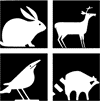Wildlife Damage Management, Internet Center for
Date of this Version
2009
Abstract
Voles (Microtus spp.) are ubiquitous to the northern hemisphere. Numerous species occur in North America and several species cause significant damage of various types: food crops, livestock forage production (e.g., alfalfa), nursery trees, reforestation, orchards, rangeland forage, and damage to lawns, golf courses and ground cover. Much research has been conducted with voles and a number of management options have been developed, including habitat manipulation, rodenticides, traps, repellents, barriers, supplemental feeding, and increased natural predation. However, significant damage still occurs because voles are not easily managed. Voles are small and secretive, prolific, active year-round, able to exploit refugia, and cyclic with periodic irruptions. Currently there are no permanent solutions to managing voles, so long-term monitoring and management of populations is required. We review what is known about voles, the types and extent of damage they cause, advantages and disadvantages of management methods, and some research needs. Research needs include the development of effective repellents, effective rodenticide baiting strategies that minimize nontarget hazards, and cost-effective methods to protect the root systems of woody plants.


Comments
Published in Proceedings of the 13th WDM Conference (2009). (J. R. Boulanger, editor). 2009.